Great fillings are essential to successful dumpling making. This guide offers ideas, tips and troubleshooting tricks. Four dumpling filling examples are also included.
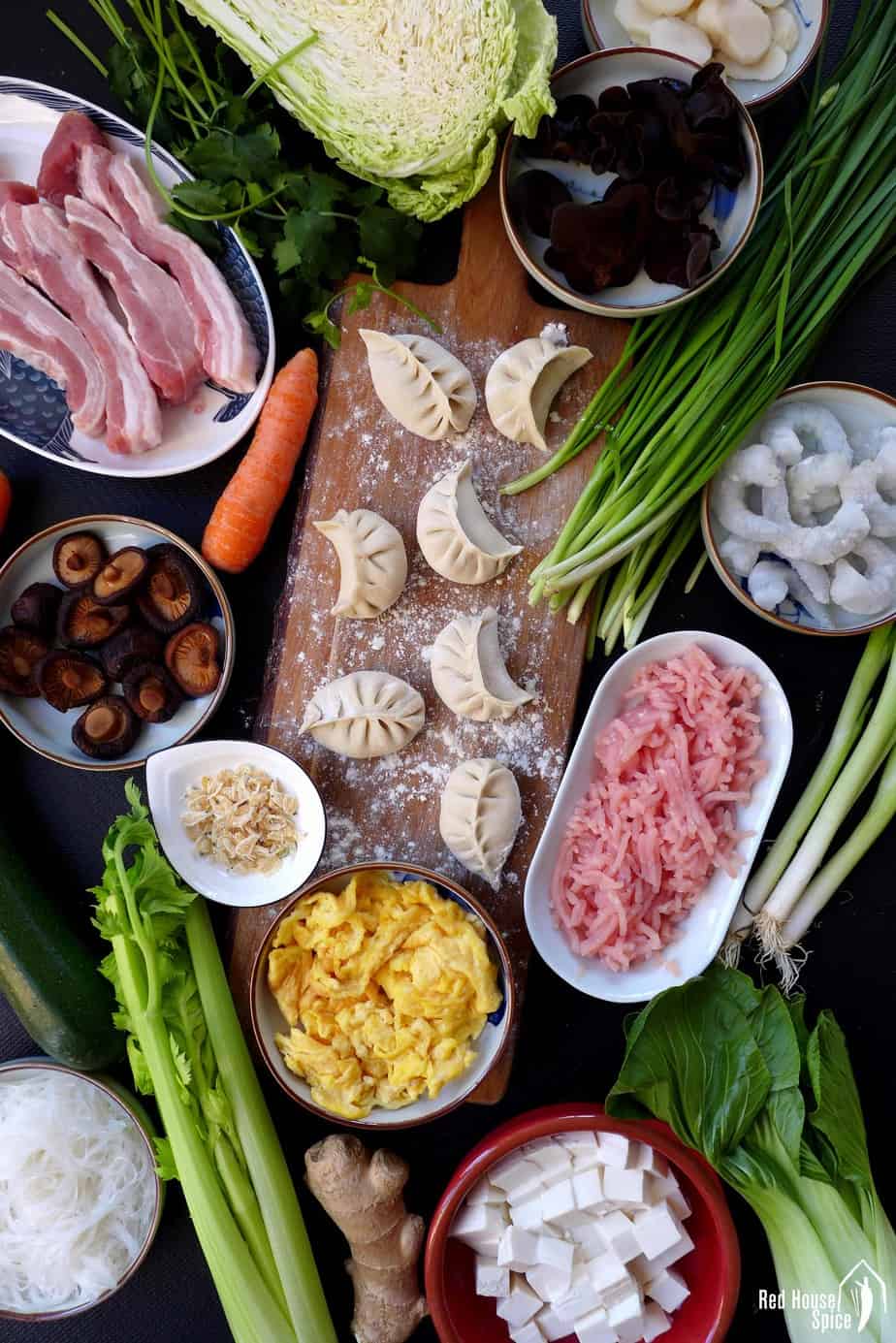
What makes a great filling for dumplings? I would say:
- A nice balance between the main ingredients
- A great combination of flavours
- A moist, juicy texture
In the second part of my Ultimate Dumpling Guide, I’m sharing numerous tips to help you to achieve those goals. Four different filling recipes are also provided, including vegetarian and vegan versions.
Chinese regional dumpling fillings
In different regions of China, dumplings are filled with different combinations of ingredients. Let me name a few popular ones.
- Zhong Shui Jiao (钟水饺, Sichuan spicy dumplings from Sichuan cuisine) are made of minced (almost pureed) pork and served with a spicy sauce.
- In Northeast regions of China, pork and Chinese sauerkraut dumplings (猪肉酸菜水饺) is a local specialty.
- The most famous dumpling dish in the historic city of Xi’an is Hot and sour dumpling soup (酸汤水饺) in which dumplings are filled with beef and yellow Chinese chive.
- Beijing families enjoy pork and Chinese leek (猪肉大葱水饺) filling.
- In the coastal province of Shangdong, people take a lot of pride in their Bayu dumplings (鲅鱼饺子) which call for Spanish mackerels.
- The famous Cantonese dim sum dish Har gow (水晶虾饺) are semi-transparent dumplings filled with prawns, bamboo shoot and water chestnut.
- Steamed crab roe dumpling (蟹黄蒸饺) is a delectable speciality of Yangzhou in Jiangsu province.
- In Chinese Muslim community, lamb dumplings (羊肉饺子) are very popular, usually paired with carrot or Chinese cabbage.
What to use in dumplings?
When it comes to dumpling fillings, there are so many choices. Use your imagination to mix and match whatever ingredients you fancy.
Apart from meat, fish and seafood that are used in the regional specialities I mentioned above, vegetables play a very important role. They are either mixed with meat / fish / seafood or stand on their own. Chinese cabbage, Chinese chive, fennel leaves, courgette, carrot, daikon, stem lettuce, aubergine, tomato, cucumber, celery, spinach, coriander, bamboo shoot…… The list goes on.
For vegetarian versions of dumpling fillings, egg and tofu are popular sources of protein.
- Eggs are scrambled before cutting into small pieces and mixing with other ingredients.
- To make tofu filled dumplings, drain as much excess water as possible beforehand (You may do so by putting a heavy object onto the tofu block). If using soft tofu, it’s better to blanch it in boiling water for a few minutes. This will help it stay in shape without getting too mushy.
There are a few more special ingredients that I’d like to recommend for dumpling fillings.
- Dried shrimp (虾米/虾皮) provides a delectable fishy flavour. Add a little if you think your filling tastes rather bland.
- Shiitake mushroom (香菇) is a magical ingredient also. Its unique umami taste can effectively elevate the deliciousness of your filling.
- Wood ear mushroom (木耳) doesn’t have much flavour on its own but it’s great at offering a springy texture.
- Water chestnut (荸荠) has a sweet, earthy taste and a crunchy texture. It’s one of my favourite addition.
- If you love the taste of herbs like coriander & dill, add a little to your filling.
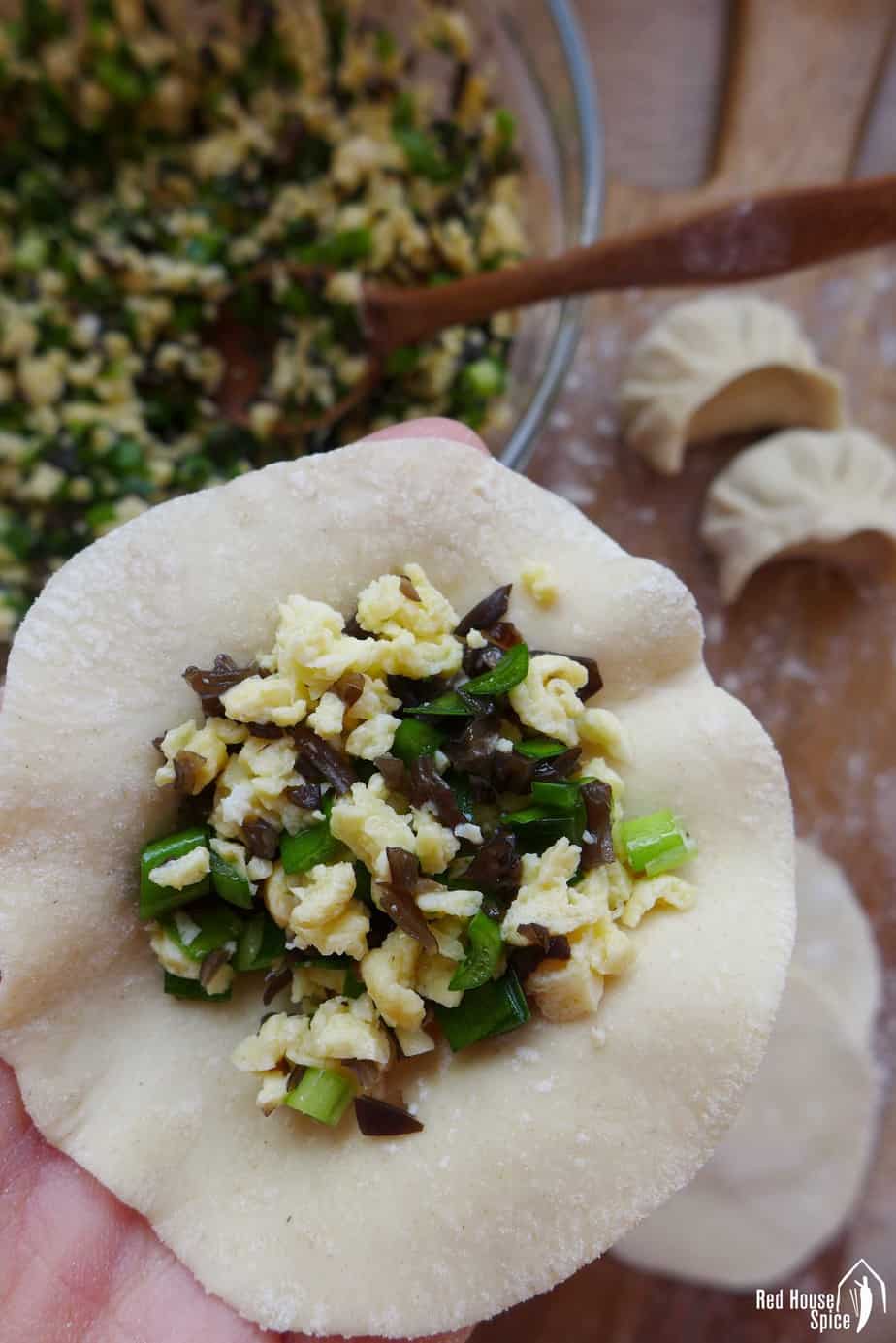
How to make it moist & juicy?
When preparing meat based fillings, the most common problem home cooks face is how to make it moist and juicy. I have a few tips to offer.
INCLUDE FAT CONTENT: I would recommend no less than 20% of fat, for example for pork fillings. If you can’t find ready to use minced meat that has a high percentage of fat, buy some nice cuts of meat then mince it yourself: with a cleaver or a food processor (I found a good article that clearly explains “How to grind your own meat in the food processor”).
ADD COOKING OIL: If you prefer non animal fat, add some cooking oil instead (rapeseed, sunflower, vegetable, peanut, etc.). My favourite way is to heat up the oil then pour over chopped spring onion / ginger. It really brings out the best flavour!
“BEAT” LIQUID IN: This process is called Daxian (打馅) in Chinese which literally means “beat the filling”.
- The liquid can be water, stock, liquid that you squeeze out from salt-wilted vegetables or water in which you have soaked shiitake mushroom.
- Add the liquid of your choice gradually into the meat while constantly swirling the meat in one direction.
- Add seasoning for the filling during this process.
- You would be surprised how much liquid the meat can absorb. Usually for 250g / 9oz meat, I add about 6 tablespoons of liquid.
- The well “beaten” meat should be sticky, soft but with no sign of any liquid.
MIX WITH MEAT ASPIC: This is the secret weapon which makes the famous Xiao Long Bao (小笼包, Soup dumplings) super juicy.
- The meat aspic can be made of pork rind, beef tendon or chicken (with bones in).
- Simmer the meat in water (with some spices if you wish) for 1-2 hours, then drain. Leave the clear liquid to cool then store in the fridge to firm up. Please refer to my post on “Pork rind jelly (肉皮冻)” for cooking instructions.
- Chop the aspic into small piece then mix into the dumpling filling. Use immediately otherwise store in the fridge for later use.
How to fix a wet filling
It’s important to make the filling moist. However, you might encounter another problem when using vegetable(s): the filling is too wet thus makes dumpling assembly challenging. To minimize the potential problem, I suggest you:
If preparing a meat and veggie filling:
- Add a little salt to chopped vegetable(s) then leave to rest for 10 minutes or so. This will help to draw out extra liquid. Squeeze before using.
- Mix meat and the vegetable(s) at the last moment when you are ready to assemble the dumplings. This is to reduce the chance of more liquid coming out the vegetable.
If preparing a vegetable filling:
- Use the same method explained above to draw liquid out of the vegetables.
- Add chopped mung bean vermicelli or sweet potato glass noodles to the filling. They are great at absorbing moisture. Scrambled eggs is another option which does the same job as well as providing another layer of flavour.
If the filling does get too wet:
- Tilt the mixing bowl to allow the liquid to flow to one corner.
- Use a spoon to squeeze the filling before placing onto the wrapper.
In any case, you need to follow another two rules:
- Do not leave the filling to sit for too long before assembling the dumplings.
- Once the dumplings are ready, cook them straightaway or freeze them immediately for later use. Otherwise the moisture from the filling would make the wrappers wet and therefore easy to tear.
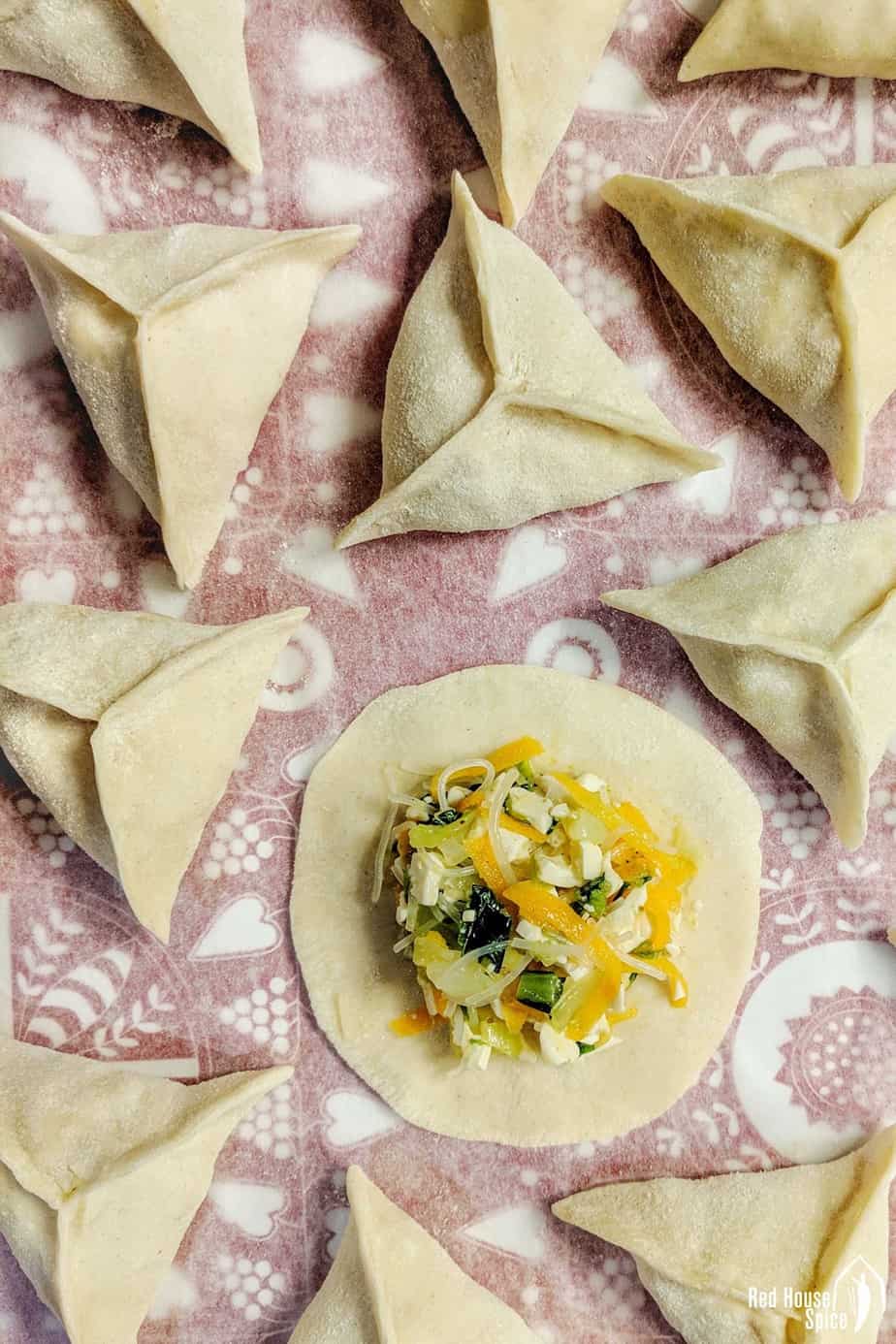
How to season the filling?
The regular seasoning for dumpling fillings includes salt, soy sauce, oyster sauce, ground Sichuan pepper / Chinese five-spice powder, white pepper, etc. A dash of sesame oil is always a good addition (but not so much that it overpowers the main flavour). Some people prefer adding a pinch of sugar to balance the saltiness.
Finely chopped spring onion and/or minced ginger are often added to the filling, especially for meat based ones. Some ingredients, such as Chinese chive, have a very strong aroma, therefore you wouldn’t need much seasoning. Some salt and a few drops of sesame oil are enough.
When you add salt to the filling, always consider if you are going to serve cooked dumplings with a dipping sauce or not. If you are including a dipping source then you will need to cut down on the salt.
Popular dumpling recipes
Here are some classic dumpling dishes that you might find interesting:
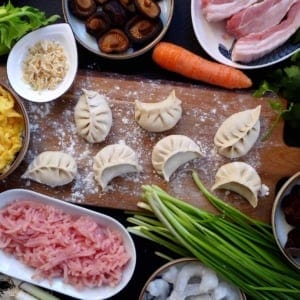
How to make great dumpling fillings
Ingredients
For Pork Filling
- 200 g minced pork - 7oz
- ½ teaspoon salt
- 2 tablespoon scallions, finely chopped
- 1 teaspoon minced ginger
- ¼ teaspoon ground Sichuan pepper - or Chinese five-spice powder
- 1 teaspoon light soy sauce
- 1 teaspoon oyster sauce
- ½ teaspoon sesame oil
- 5 tablespoon water / stock
- 300 g celery, finely chopped - 10oz
- 2 tablespoon coriander, finely chopped
For Chicken Filling
- 100 g Shiitake mushrooms - soaked & finely chopped, 3.5oz
- 250 g minced chicken - 9oz
- ½ teaspoon salt
- 1 pinch ground Sichuan pepper - or Chinese five-spice powder
- 1 teaspoon light soy sauce
- 80 g water chestnut, finely chopped - 3oz
- 2 tablespoon cooking oil
- 1 tablespoon scallions, finely chopped
For Vegetarian Egg Filling
- 2 tablespoon cooking oil
- 4 eggs - lightly beaten
- 60 g Chinese chive, finely chopped - 2oz
- 60 g wood ear mushroom (soaked & finely chopped) - 2oz
- ½ teaspoon salt
- ½ teaspoon sesame oil
For Vegan Tofu Filling
- 200 g soft tofu - 7oz
- 100 g pak choi - 3.5oz
- ½ teaspoon salt
- 2 tablespoon cooking oil
- 2 tablespoon scallions, finely chopped
- 80 g carrot, grated - 3oz
- 100 g mung bean vermicelli, soaked & coarsely chopped - 3.5oz
- 1 pinch ground Sichuan pepper - or white pepper
- ½ teaspoon sesame oil
Instructions
For Pork Dumpling Filling
- Place pork in a mixing bowl. Add scallions, ginger, ¼ teaspoon salt, Sichuan pepper / five-spice, soy sauce, oyster sauce and sesame oil.
- Gradually add water to the meat while swirling in one direction until no more liquid can be seen.
- Add the remaining salt to the celery then leave to rest for 10 minutes. Squeeze out excess liquid then add to the meat. Mix well with coriander.
For Chicken Dumpling Filling
- Soak shiitake mushrooms in water (ideally overnight) then chop into small pieces (remove the stem).
- Place chicken in a mixing bowl. Add salt, Sichuan pepper / five-spice and soy sauce.
- Gradually add 5 tablespoons of the water in which the mushrooms have been soaked to the meat while swirling in one direction until no more liquid can be seen.
- Add chopped mushrooms and water chestnut. Place scallions on top of the mixture. Pour hot oil over then mix well.
For Egg Dumpling Filling (Vegetarian):
- Heat up oil in a wok / frying pan. Pour in the egg when the oil smokes. Dish out as soon as there is no more liquid. Coarsely chop when it cools down.
- Add Chinese chive, wood ear mushroom, salt and sesame oil. Mix well.
For Tofu Dumpling Filling (Vegan):
- Blanch tofu in boiling water for 2 minutes. Drain and cut into small pieces.
- Briefly blanch pak choi then chop small. Add ¼ teaspoon salt. Leave to rest for 10 minutes then squeeze out excess liquid.
- Heat up oil in a wok / frying pan. Add scallions, carrot and the remaining salt. Fry until soft.
- Put all the ingredients into a bowl then mix well.
Video
NOTES
- 25g dried Shiitake mushrooms weight about 100g after soaking
- 6g dried wood ear mushrooms weight about 60g after soaking
- 35g dried mung bean vermicelli weight about 100g after soaking
NUTRITION DISCLOSURE: Nutritional information on this website is provided as a courtesy to readers. It should be considered estimates. Please use your own brand nutritional values or your preferred nutrition calculator to double check against our estimates.
Hope you have enjoyed reading my tips on dumpling fillings. For more dumpling recipes, have a look at the following posts
- Home made dumpling wrappers
- Ten ways to fold dumplings
- Cook dumplings in three ways
- Bi-colour pan-fried vegetarian dumplings (素煎饺)
- Beef dumplings in hot & sour soup (酸汤水饺)
- Har gow: crystal prawn dumplings (虾饺)
- Chinese chive pockets (韭菜盒子)


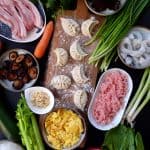
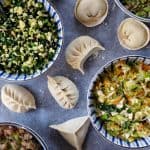
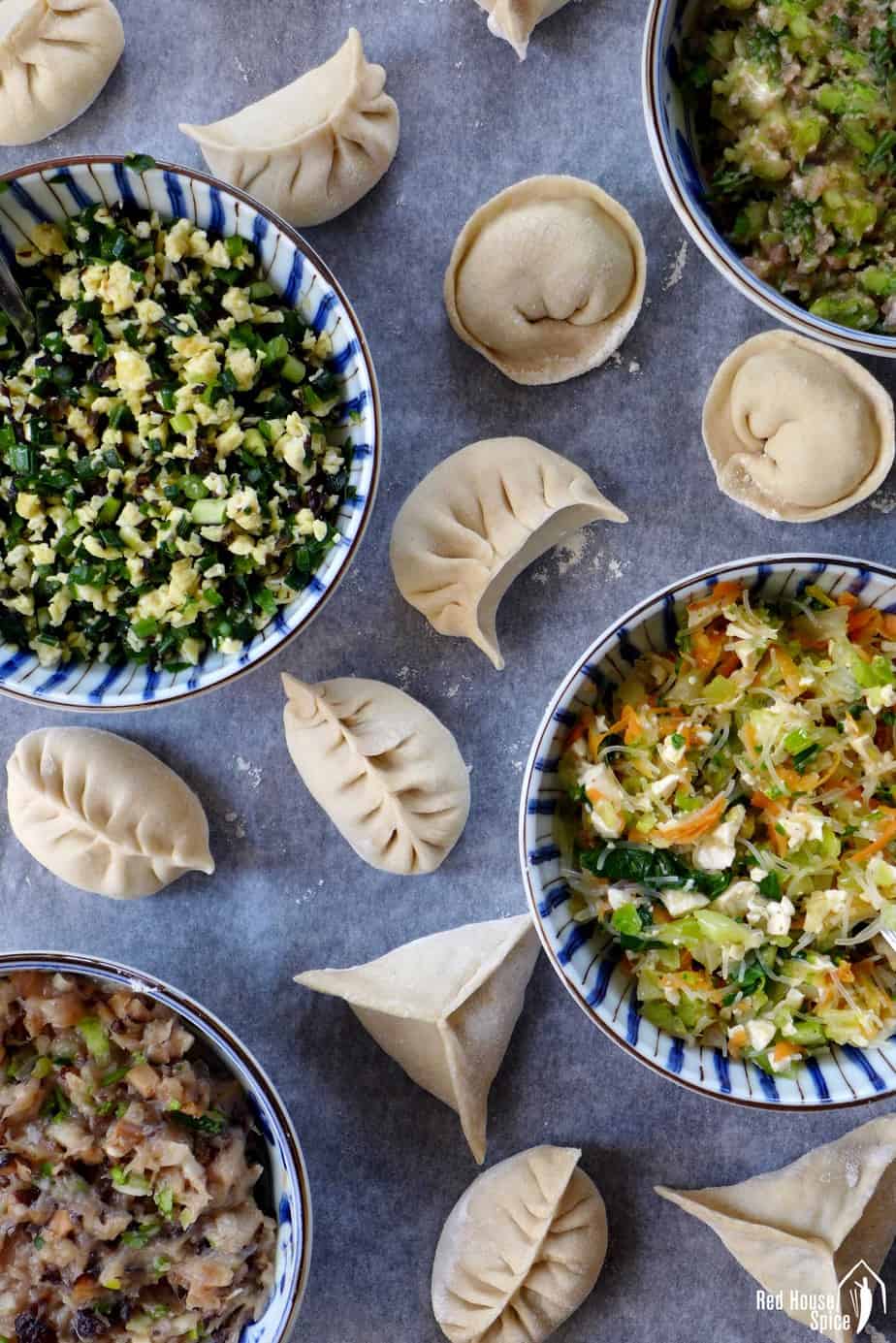

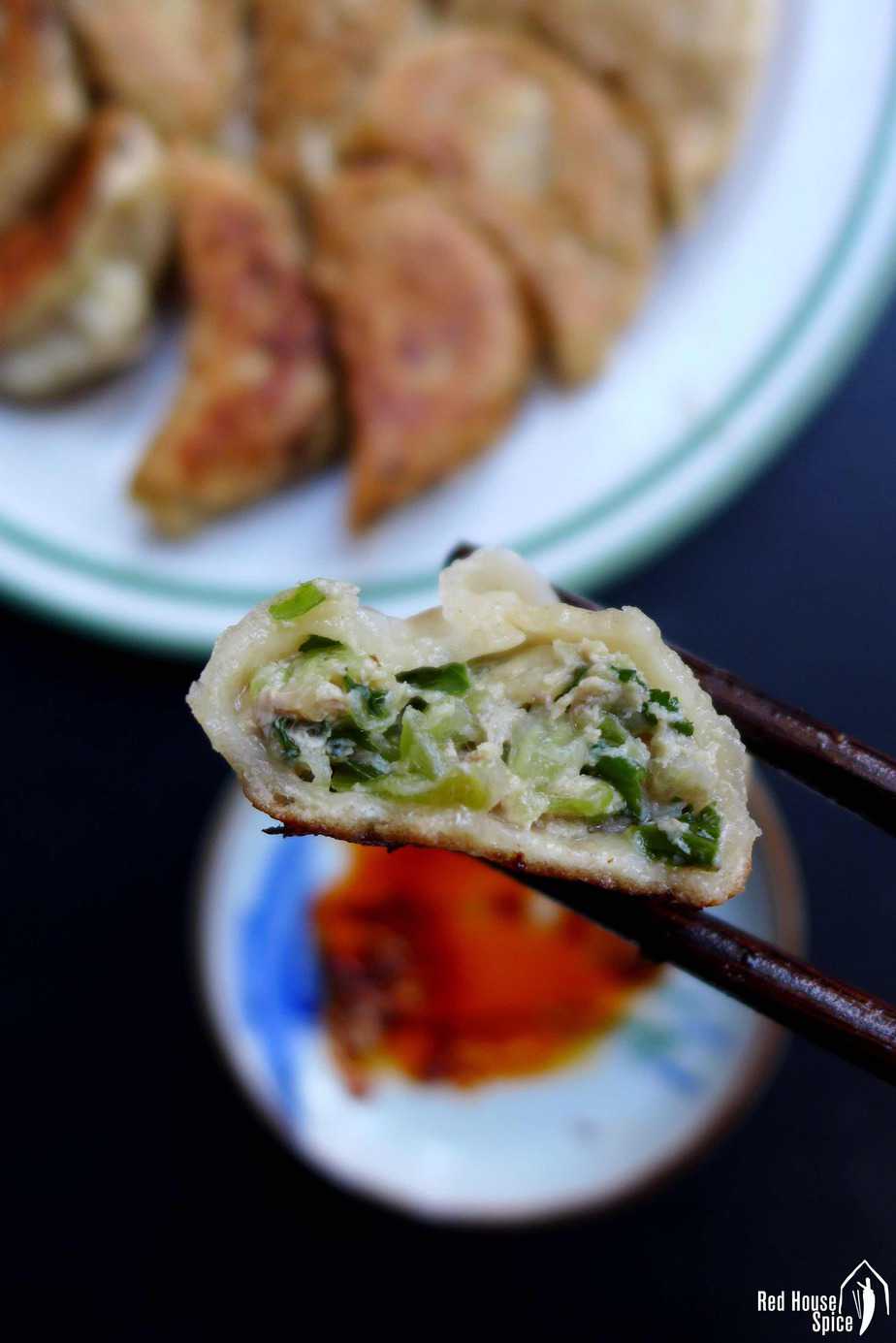
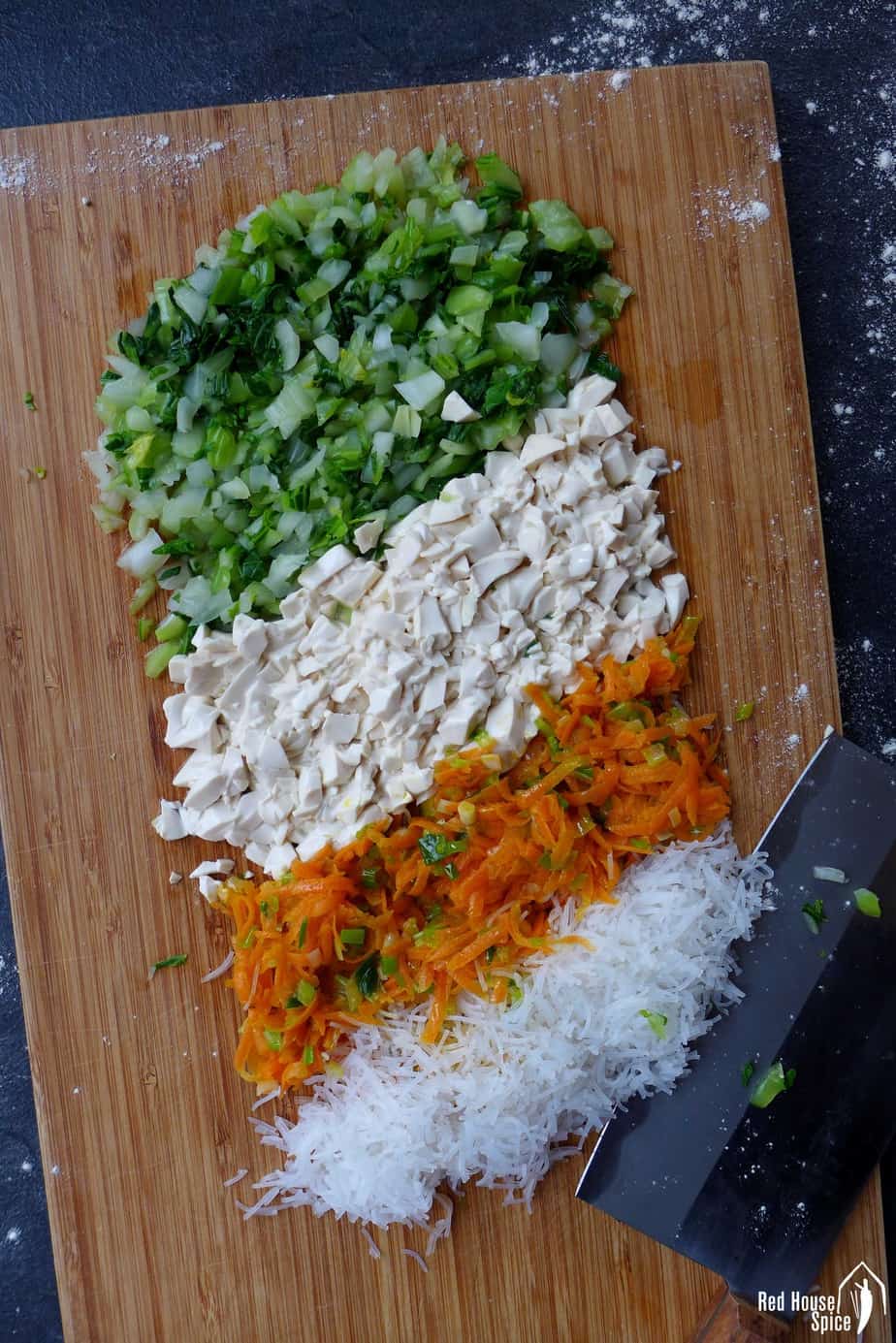
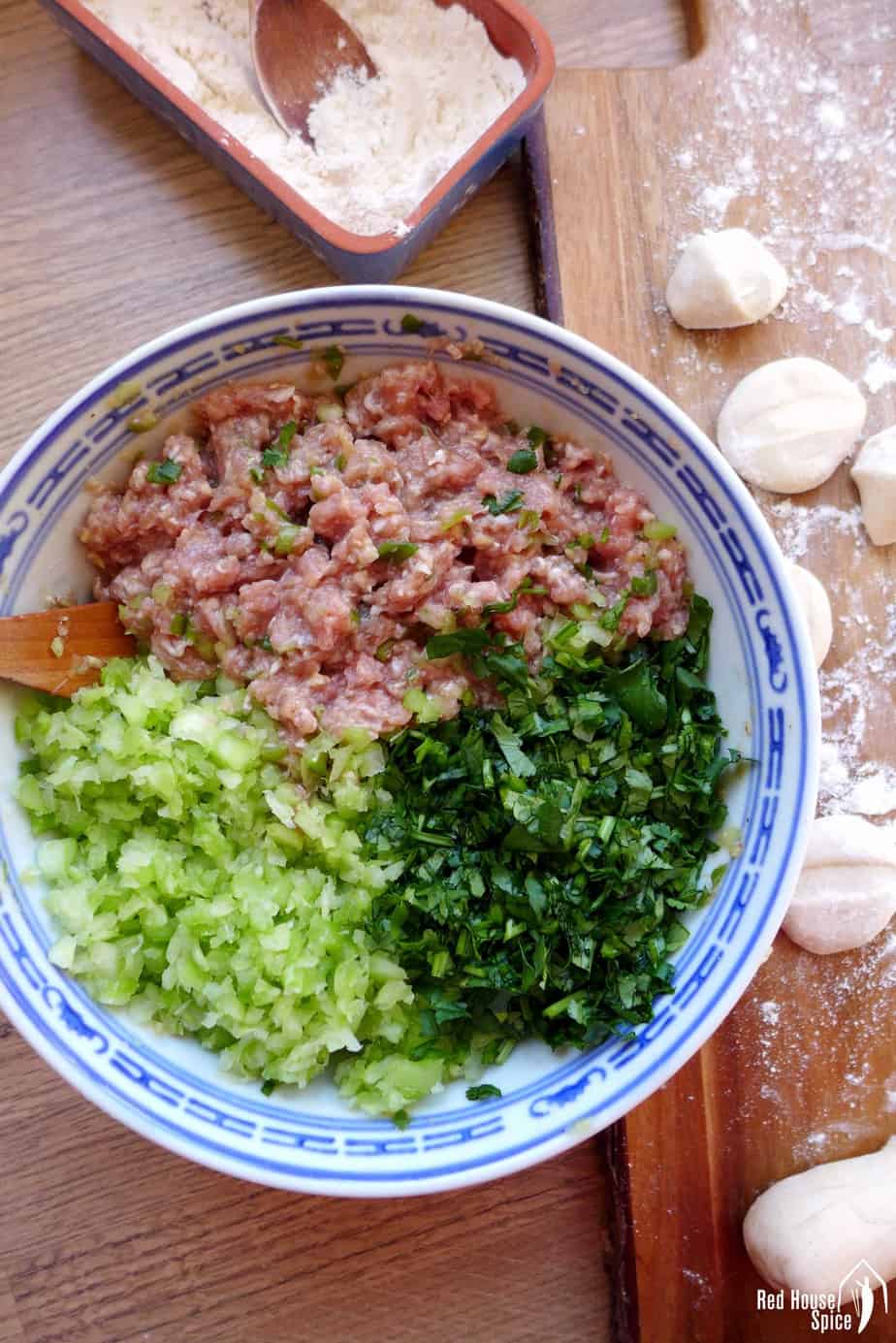
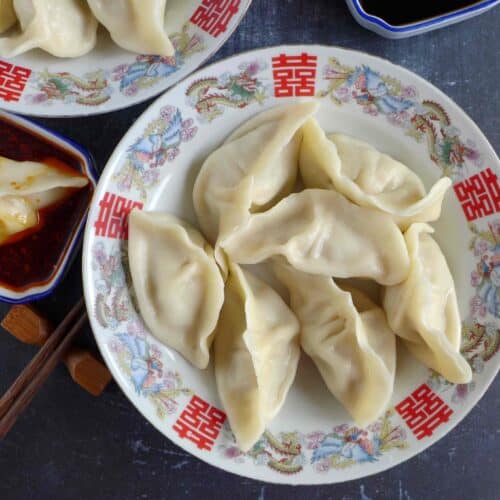
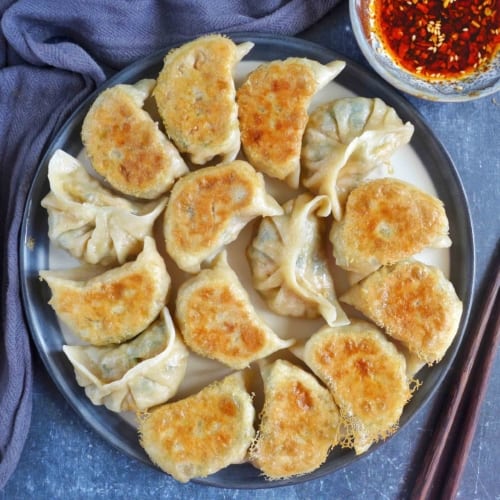
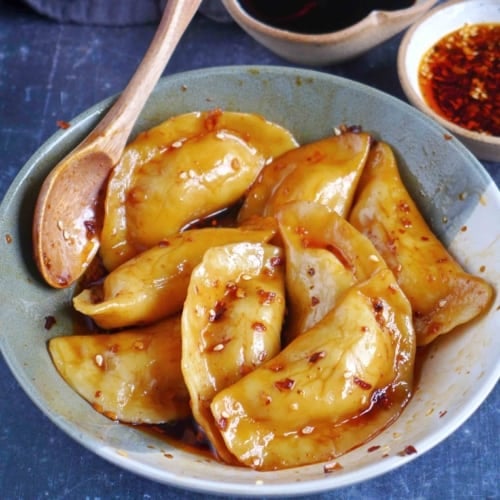
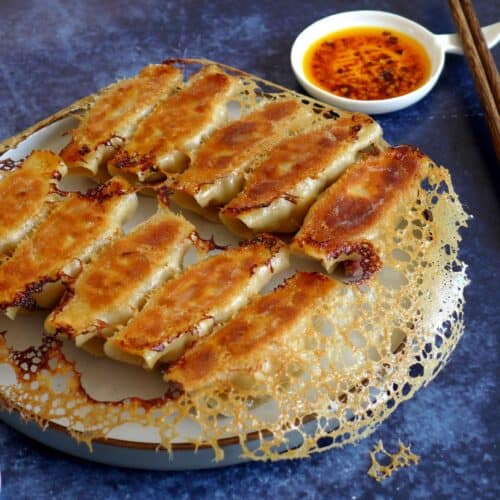
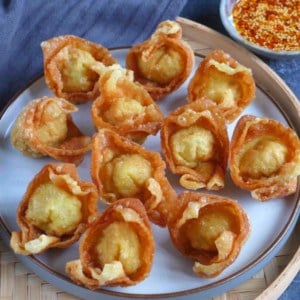
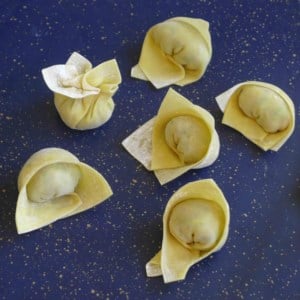
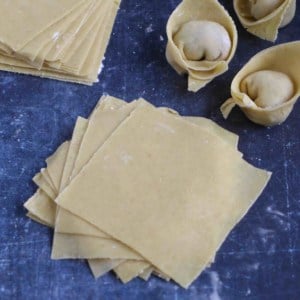
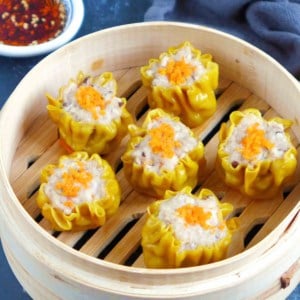
Love this. I cook the Chicken recipe. Thank you.
Wonderful to hear that Theresa!
Hi having a dinner part this weekend and was looking to get ahead with prep so was wondering after assembling the dumplings would you freeze them straight away or cook first then freeze. Can’t wait to hive these a go 🙂
Once assembled, freeze them straightaway. Cook without defrosting. You can find detailed instructions in the “storage” section of my Dumpling Guide. Happy cooking Emma!
First attempt ok for a country boy working in my Memaw’s kitchen but your directions and attention to detail is astounding. You should work for NASA- thank you for this wonderfully organized and exhaustive tutorial on dumplings.
You’re welcome John and thank you for your kind words! Have fun making dumplings!
The pork filling is now my go to recipe, so delicious!!
That’s wonderful to hear! Thank you for trying out my recipe Sonia!
You’ve really demystified the process of making dumplings – thank you! I was able to make wrappers from scratch and also how to make a “crispy skirt” from your recipes. One question – how would you make a dill filling for dumplings? I’ve tried adapting a traditional napa cabbage-and-pork filling by substituting dill for the napa cabbage, but it doesn’t taste right.
Glad you find my dumpling guide helpful! I think you’re talking about classic Hui Xiang dumplings (茴香饺子). Based on my experience, Chinese Hui Xiang resembles fennel (the leafy part, not the bulbs) more than dill. But none of the two tastes exactly like Hui Xiang found in China.
Hii ╰(*°▽°*)╯This collection of recipes are awesome. I felt like I discovered a treasure when I stumbled upon your blog. i have made potstickers once and these recipes gave me a bunch of new ideas and i got to know a lot of things i did not know. Thank you very much ❤
That’s wonderful to hear Gayani! Enjoy your dumpling making journey!
Hi Wei, first thing first…your series about dumpling is AMAZING!! Thank you so much for sharing!!
Very quick question for you: what part of the pork do you recommend to use for the filling? I live in Ireland and normally the mince pork is very lean, so I am going to buy pork and mince it myself so I can pick a fattier piece of pork. Would pork shoulder or pork belly work? Thanks a lot!!
Welcome to my blog Ivan! Both pork shoulder and pork belly work well for a tasty filling. Happy cooking!
Great! Thanks a lot Wei!
Hi Wei, I just discovered your amazing blog 🙂
I was asking myself the same question ! What do you think about pork neck ? And which cut do you personally like using ?
When I ask the butcher the fattiest cut, he always refers me to pork neck which I find odd because I thought the belly was the fattiest, but maybe I am mistaken ! I would love to know which cut you like using the best.
Lots of love from Switzerland !
Hi Sheila! Both pork belly and pork neck are good for making minced meat. The latter may have a little less fat but still a flavourful cut that’s good for dumpling fillings.
Thank you Wei !
How about just showing the recipe and less commentary
Thank you Joe for visiting my blog! I’ve learnt from many readers that they appreciate very much the explanation and cooking tips that I provide as they helps them to succeed. If you feel confident to use my recipe without extra information, please feel free to read the recipe card only.
Hi Wei,
I have really been enjoying your dumpling guide and some of your other recipes! The sweet spiced soy for the dumpling sauces is fantastic. I have some fresh rockfish and would like to make some dumplings with it. I’ve had a dumpling at a restaurant that i think may have been fish, celery, and white pepper that was really good. Can you recommend a dumpling filling recipe for rockfish?
Thank you so much for your wonderful recipes!
Laura
Hi Laura, you could use the recipes in this post and replace pork, chicken or egg with minced rockfish. I’m sure it will taste great!
These look great! Do you think I can pre-make the filling the day before as long as I don’t add the veggies in with it?
Yes you can Melissa. Happy cooking!